tailgate HONDA ELEMENT 2010 1.G Owners Manual
[x] Cancel search | Manufacturer: HONDA, Model Year: 2010, Model line: ELEMENT, Model: HONDA ELEMENT 2010 1.GPages: 342, PDF Size: 5.76 MB
Page 5 of 342

Trip meter................................ 66
Gearshift Lever Positions
Automatic Transmission ....................... 219
Manual Transmission ..............217
Glove Box .................................. 100
Gross Axle Weight Rating
(GAWR) ................................. 232
Gross Vehicle Weight Rating (GVWR) .......................... 209, 232
H
Halogen Headlight Bulbs ...........261
Hatch ........................................... 81
Hazard Warning Flashers ............73
Headlights Aiming .................................... 261
Daytime Running Lights ..........72
High Beam Indicator ................61
High Beams, Turning on ..........71
Lights On Indicator ..................61
Low Beams, Turning on ...........71
Reminder Chime ......................71
Replacing Halogen Bulbs ........261 Turning on
............................... 71
Head Restraints ............................ 85
Heating and Cooling ..................104
High Altitude, Starting at ............216
Hood, Opening and Closing the .......................................... 200
Horn ........................................ 4, 69
Hydraulic Clutch ........................258
I
Identification Number, Vehicle ................................... 306
Ignition
Keys ......................................... 75
Switch ...................................... 79
Immobilizer System .....................76
Important Safety Precautions .........6
Indicators, Instrument Panel ........57
ABS (Anti-lock Brake) .......59, 226
Brake (Parking and Brake
System) ......................... 58, 297
Charging System ..............58, 295
Cruise Control .......................... 60
Cruise Main ............................. 60Door and Tailgate Open
...........61
DRL (Daytime Running
Lights) .................................. 60
High Beam ............................... 61
Key (Immobilizer System) .......60
Lights On ................................. 61
Low Fuel .................................. 61
Low Oil Pressure ..............58, 295
Low Tire Pressure .............62, 227
Maintenance Minder .........59, 243
Malfunction Indicator
Lamp ............................. 58, 296
Passenger Airbag Off ...............32
Seat Belt Reminder .............18, 58
Side Airbag Off ....................32, 59
SRS ..................................... 31, 59
TPMS ................................ 63, 228
Turn Signal and Hazard Warning ............................... 60
VSA OFF .................................. 62
VSA System ............................. 62
Washer Level ........................... 61
Individual Map Lights ..................95
Infant Restraint ............................ 40
CONTINUED
Index
V
INDEX
Page 6 of 342

Infant Seats.................................. 40
Tether Anchorage Point ...........48
Inflation, Proper Tire ..................271
Recommended Pressures .......272
Inside Mirror ............................... 93
Inspection, Tire .......................... 273
Installing a Child Seat ..................43
Instrument Panel ..........................57
Instrument Panel Brightness .......72
Instruments and Controls .............55
Interior Lights .............................. 95
Introduction ................................... i
iPod
®.......................................... 162
iPod®Error Messages ................172
J
Jacking up the Vehicle ...............283
Jack, Tire ................................... 283
Jump Starting ............................. 291
K
Keys ............................................. 75L
Label, Certification
.....................306
Lane Change, Signaling ...............71
Lap/Shoulder Belt .................14, 19
LATCH Anchorage System ..........44
Light Control Switch ....................95
Lights
Bulb Replacement ...................261
Indicator ................................... 57
Interior ..................................... 95
Parking .................................... 71
Turn Signal .............................. 71
Load Limit .................................. 208
LOCK (Ignition Key Position) ......79
Locks
Anti-theft Steering Column .......79
Fuel Fill Door .......................... 199
Glove Box ............................... 100
Hatch ....................................... 81
Lockout Prevention ..................81
Power Door .............................. 80
Tailgate .................................... 82
Low Coolant Level ......................201
Lower Anchors ............................. 44Low Fuel Indicator
.......................61
Low Oil Pressure
Indicator ........................... 58, 295
Lubricant Specifications Chart ...309
Luggage, Storing (cargo) ...........207
M
Maintenance .............................. 241
Main Items and Sub Items ......246
Minder .................................... 243
Minder Indicator ......................59
Owner's Maintenance
Checks ................................ 248
Safety ...................................... 242
Schedule ................................. 249
Malfunction Indicator Lamp ................................ 58, 296
Manual Transmission .................217
Checking Fluid Level ..............257
Shifting ................................... 217
Manual Transmission Fluid .......257
Meters, Gauges ............................ 64
Methanol in Gasoline .................198
Mirrors, Adjusting ........................93
Index
VI
Page 10 of 342

Tailgate........................................ 82
Open Indicator ......................... 61
Opening the ............................. 82
Taillights, Changing Bulbs in .....266
Taking Care of the Unexpected ............................ 281
Technical Descriptions
DOT Tire Quality Grading (U.S. Vehicles) ............................. 311
Emissions Control Systems .....316
Three Way Catalytic
Converter ............................ 318
Tire Labeling ........................... 313
Tire Pressure Monitoring System (TPMS) -Required Federal
Explanation ...................... 314
Temperature Gauge .....................67
Tensioners, Seat Belts ..................20
Tether Anchorage Points .............48
Theft Protection, Radio ..............188
Three Way Catalytic
Converter ............................... 318
Tilt the Steering Wheel ................74
Time, Setting the ........................189
Tire Chains ................................ 276
Tire, How to Change a Flat ........283 Tire Information
.........................313
Tire Labeling .............................. 313
Tire Pressure Monitoring System (TPMS) ........................... 227, 314
Tires .......................................... 271
Air Pressure ............................ 272
Chains ..................................... 276
Checking Wear .......................273
Compact Spare ........................282
DOT Tire Quality Grading (U.S. Vehicles) ............................. 311
Inflation ................................... 271
Inspection ............................... 273
Labeling .................................. 313
Low Tire Pressure
Indicator ........................ 62, 227
Maintenance ........................... 274
Pressure Monitoring System ...227
Replacing ................................ 274
Rotating .................................. 274
Snow ....................................... 275
Specifications .......................... 310
Tools, Tire Changing .................283
Towing A Trailer .................................. 232
Emergency Wrecker ...............303TPMS (Tire Pressure Monitoring
System) .............................. 227
Indicator ............................ 63, 228
Required Federal
Explanation ......................... 314
Transmission Checking Fluid Level,
Automatic ............................ 256
Checking Fluid Level, Manual ................................ 257
Fluid Selection ................256, 257
Identification Number .............306
Shifting the Automatic .............219
Shifting the Manual .................217
Treadwear .................................. 311
Trip Meter ................................... 66
Turn Signals ................................. 60
Turn Signals and Headlights ........71
U
Unexpected, Taking Care of the .......................................... 281
Uniform Tire Quality Grading (U.S. only) .............................. 311
Index
X
Page 27 of 342
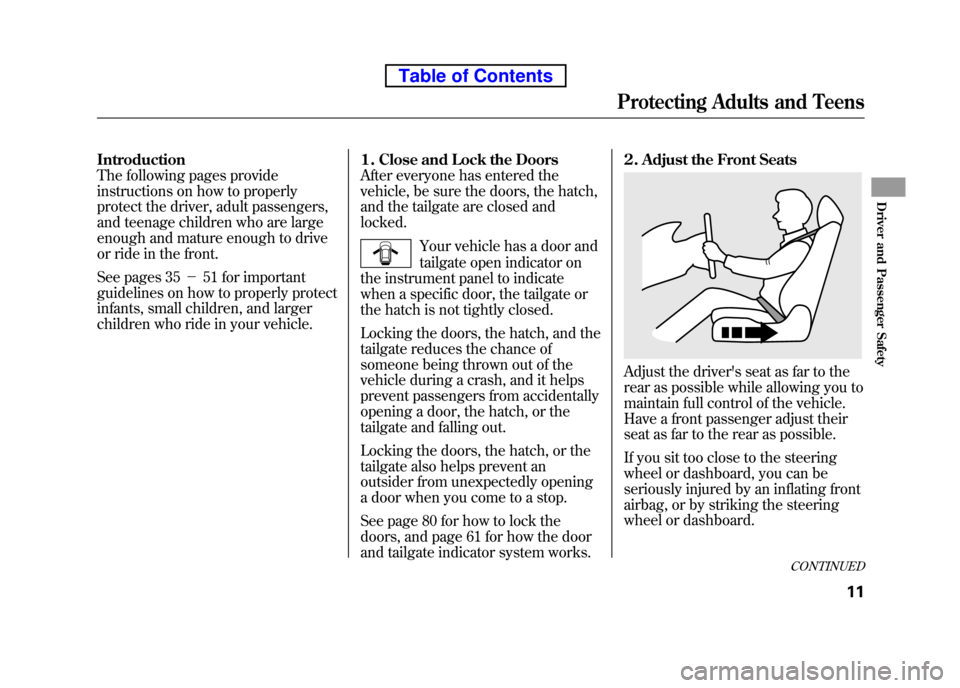
Introduction
The following pages provide
instructions on how to properly
protect the driver, adult passengers,
and teenage children who are large
enough and mature enough to drive
or ride in the front.
See pages 35-51 for important
guidelines on how to properly protect
infants, small children, and larger
children who ride in your vehicle. 1. Close and Lock the Doors
After everyone has entered the
vehicle, be sure the doors, the hatch,
and the tailgate are closed and locked.
Your vehicle has a door and
tailgate open indicator on
the instrument panel to indicate
when a specific door, the tailgate or
the hatch is not tightly closed.
Locking the doors, the hatch, and the
tailgate reduces the chance of
someone being thrown out of the
vehicle during a crash, and it helps
prevent passengers from accidentally
opening a door, the hatch, or the
tailgate and falling out.
Locking the doors, the hatch, or the
tailgate also helps prevent an
outsider from unexpectedly opening
a door when you come to a stop.
See page 80 for how to lock the
doors, and page 61 for how the door
and tailgate indicator system works. 2. Adjust the Front Seats
Adjust the driver's seat as far to the
rear as possible while allowing you to
maintain full control of the vehicle.
Have a front passenger adjust their
seat as far to the rear as possible.
If you sit too close to the steering
wheel or dashboard, you can be
seriously injured by an inflating front
airbag, or by striking the steering
wheel or dashboard.
CONTINUED
Protecting Adults and Teens
11
Driver and Passenger Safety
Table of Contents
Page 55 of 342

Additional Safety Precautions●
Never hold an infant or child on
your lap.
If you are not wearing a
seat belt in a crash, you could be
thrown forward and crush the
child against the dashboard or a
seat-back. If you are wearing a seat
belt, the child can be torn from
your arms and be seriously hurt or killed.
●
Never put a seat belt over yourself and a child.During a crash, the
belt could press deep into the child
and cause serious or fatal injuries.
●
Never let two children use the same seat belt.If they do, they
could be very seriously injured in acrash. ●
Make sure any unused seat belt
that a child can reach is buckled,the lockable retractor is activated,
and the belt is fully retracted and
locked.
If a child wraps a loose
seat belt around their neck, they
can be seriously or fatally injured.
(See page 46 for how to activate
and deactivate the lockableretractor.)
●
Do not leave children alone in a vehicle.
Leaving children without
adult supervision is illegal in most
states, Canadian provinces/
territories, and can be veryhazardous.
For example, infants and small
children left in a vehicle on a hot
day can die from heatstroke. A
child left alone with the key in the
ignition switch can accidentally set
the vehicle in motion, possibly
injuring themselves or others. ●
Lock all doors, the tailgate and the
hatch when your vehicle is not in
use.
Children who play in vehicles
can accidentally get trapped inside.
Teach your children not to play in
or around vehicles.
●
Keep vehicle keys and remote transmitters out of the reach of
children.
Even very young
children learn how to unlock
vehicle doors, turn on the ignition,
and open the tailgate or hatch,
which can lead to accidental injury
or death.
Protecting Children -General Guidelines
39
Driver and Passenger Safety
Table of Contents
Page 68 of 342
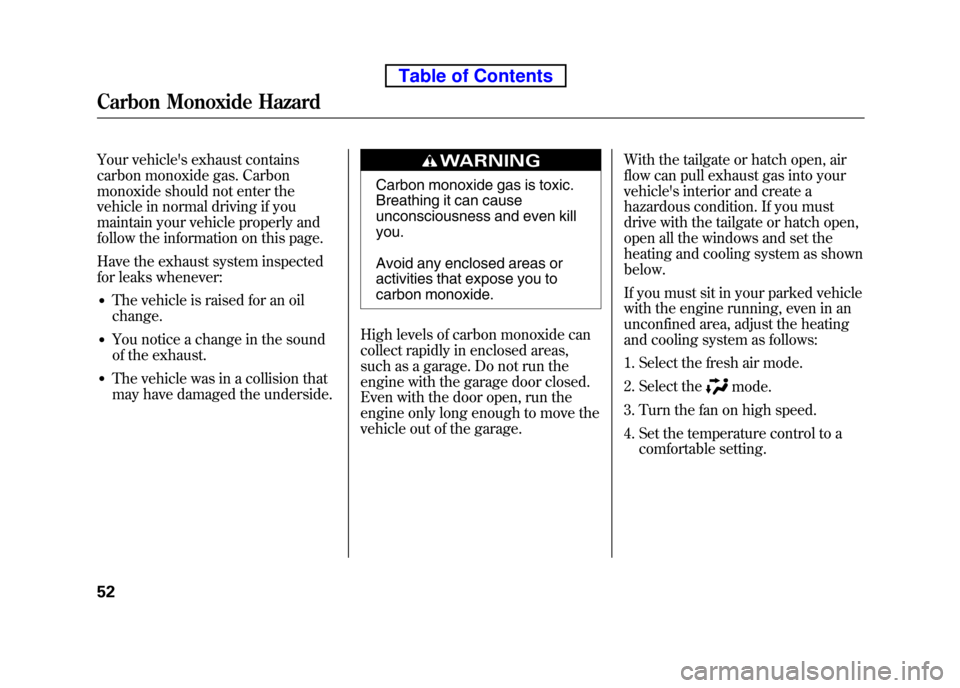
Your vehicle's exhaust contains
carbon monoxide gas. Carbon
monoxide should not enter the
vehicle in normal driving if you
maintain your vehicle properly and
follow the information on this page.
Have the exhaust system inspected
for leaks whenever:● The vehicle is raised for an oilchange.
● You notice a change in the sound
of the exhaust.
● The vehicle was in a collision that
may have damaged the underside.
Carbon monoxide gas is toxic.
Breathing it can cause
unconsciousness and even kill you.
Avoid any enclosed areas or
activities that expose you to
carbon monoxide.
High levels of carbon monoxide can
collect rapidly in enclosed areas,
such as a garage. Do not run the
engine with the garage door closed.
Even with the door open, run the
engine only long enough to move the
vehicle out of the garage. With the tailgate or hatch open, air
flow can pull exhaust gas into your
vehicle's interior and create a
hazardous condition. If you must
drive with the tailgate or hatch open,
open all the windows and set the
heating and cooling system as shownbelow.
If you must sit in your parked vehicle
with the engine running, even in an
unconfined area, adjust the heating
and cooling system as follows:
1. Select the fresh air mode.
2. Select the
mode.
3. Turn the fan on high speed.
4. Set the temperature control to a comfortable setting.
Carbon Monoxide Hazard
52
Table of Contents
Page 71 of 342
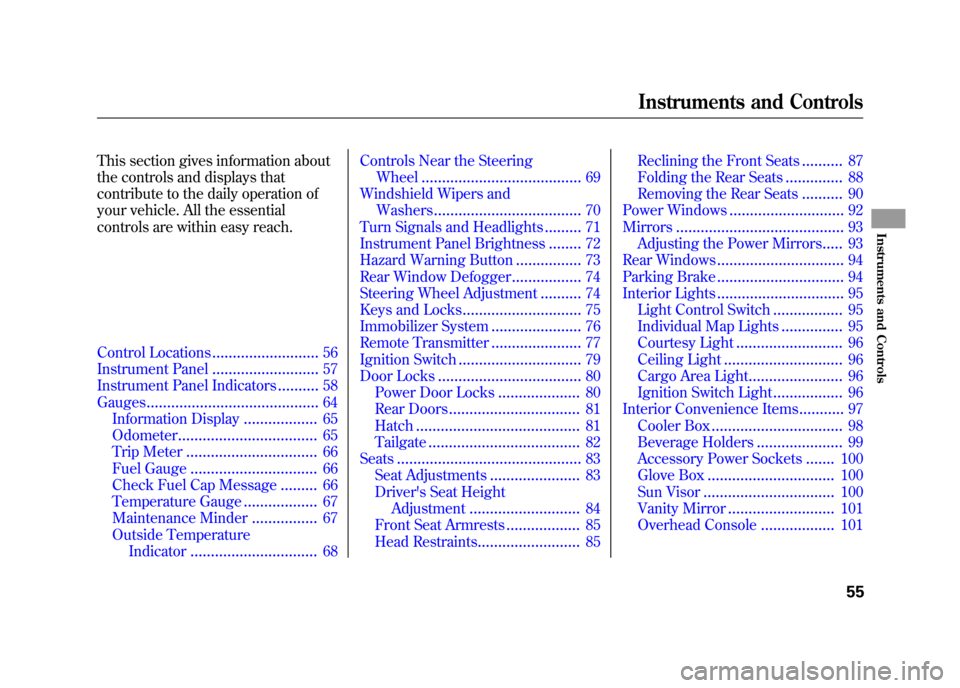
This section gives information about
the controls and displays that
contribute to the daily operation of
your vehicle. All the essential
controls are within easy reach.
Control Locations..........................56
Instrument Panel ..........................
57
Instrument Panel Indicators ..........58
Gauges ..........................................
64
Information Display ..................65
Odometer ..................................
65
Trip Meter ................................ 66
Fuel Gauge ............................... 66
Check Fuel Cap Message .........
66
Temperature Gauge ..................67
Maintenance Minder ................
67
Outside Temperature Indicator ............................... 68Controls Near the Steering
Wheel ....................................... 69
Windshield Wipers and Washers .................................... 70
Turn Signals and Headlights .........71
Instrument Panel Brightness ........
72
Hazard Warning Button ................73
Rear Window Defogger .................74
Steering Wheel Adjustment ..........
74
Keys and Locks ............................. 75
Immobilizer System ......................
76
Remote Transmitter ......................77
Ignition Switch ..............................
79
Door Locks ................................... 80
Power Door Locks ....................
80
Rear Doors ................................ 81
Hatch ........................................ 81
Tailgate .....................................
82
Seats ............................................. 83
Seat Adjustments ......................
83
Driver's Seat Height Adjustment ........................... 84
Front Seat Armrests ..................85
Head Restraints ......................... 85Reclining the Front Seats
..........
87
Folding the Rear Seats ..............
88
Removing the Rear Seats ..........90
Power Windows ............................
92
Mirrors ......................................... 93
Adjusting the Power Mirrors .....
93
Rear Windows ............................... 94
Parking Brake ............................... 94
Interior Lights ...............................
95
Light Control Switch .................95
Individual Map Lights ...............
95
Courtesy Light .......................... 96
Ceiling Light .............................
96
Cargo Area Light .......................96
Ignition Switch Light .................
96
Interior Convenience Items ...........97
Cooler Box ................................ 98
Beverage Holders .....................
99
Accessory Power Sockets .......100
Glove Box ...............................
100
Sun Visor ................................ 100
Vanity Mirror ..........................
101
Overhead Console ..................101
Instruments and Controls
55
Instruments and Controls
Page 73 of 342
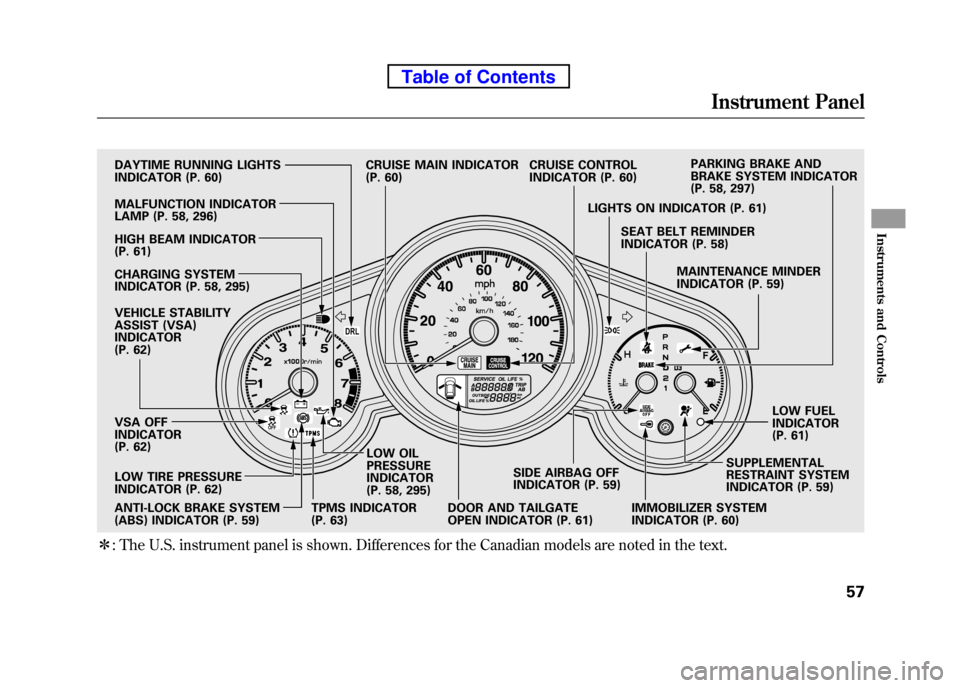
ꭧ: The U.S. instrument panel is shown. Differences for the Canadian models are noted in the text.
DRL
DAYTIME RUNNING LIGHTS
INDICATOR (P. 60)
HIGH BEAM INDICATOR
(P. 61)
CHARGING SYSTEM
INDICATOR (P. 58, 295)
VEHICLE STABILITY
ASSIST (VSA)
INDICATOR
(P. 62)
VSA OFF
INDICATOR
(P. 62)
ANTI-LOCK BRAKE SYSTEM
(ABS) INDICATOR (P. 59) LOW OIL PRESSURE
INDICATOR
(P. 58, 295)
DOOR AND TAILGATE
OPEN INDICATOR (P. 61)SIDE AIRBAG OFF
INDICATOR (P. 59)
IMMOBILIZER SYSTEM
INDICATOR (P. 60)SUPPLEMENTAL
RESTRAINT SYSTEM
INDICATOR (P. 59)LOW FUELINDICATOR
(P. 61)
MAINTENANCE MINDER
INDICATOR (P. 59)
SEAT BELT REMINDER
INDICATOR (P. 58)
LIGHTS ON INDICATOR (P. 61) PARKING BRAKE AND
BRAKE SYSTEM INDICATOR
(P. 58, 297)
CRUISE CONTROL
INDICATOR (P. 60)
TPMS INDICATOR
(P. 63) CRUISE MAIN INDICATOR
(P. 60)
MALFUNCTION INDICATOR
LAMP (P. 58, 296)
LOW TIRE PRESSURE
INDICATOR (P. 62)
Instrument Panel
57
Instruments and Controls
Table of Contents
Page 77 of 342
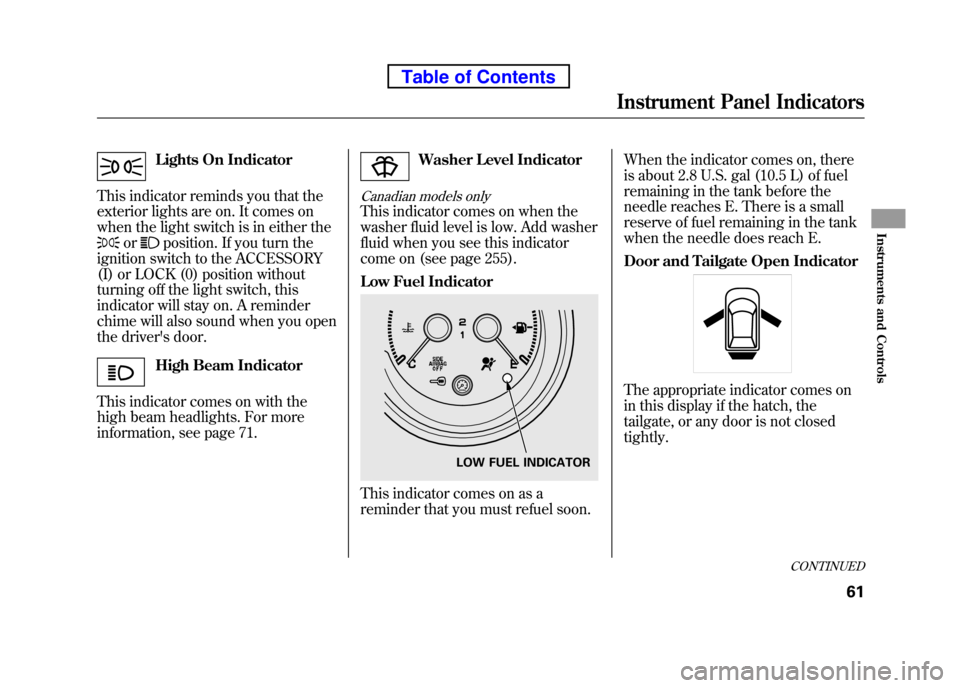
Lights On Indicator
This indicator reminds you that the
exterior lights are on. It comes on
when the light switch is in either the
orposition. If you turn the
ignition switch to the ACCESSORY
(I) or LOCK (0) position without
turning off the light switch, this
indicator will stay on. A reminder
chime will also sound when you open
the driver's door.
High Beam Indicator
This indicator comes on with the
high beam headlights. For more
information, see page 71.
Washer Level Indicator
Canadian models only
This indicator comes on when the
washer fluid level is low. Add washer
fluid when you see this indicator
come on (see page 255).
Low Fuel Indicator
This indicator comes on as a
reminder that you must refuel soon. When the indicator comes on, there
is about 2.8 U.S. gal (10.5 L) of fuel
remaining in the tank before the
needle reaches E. There is a small
reserve of fuel remaining in the tank
when the needle does reach E.
Door and Tailgate Open Indicator
The appropriate indicator comes on
in this display if the hatch, the
tailgate, or any door is not closedtightly.
LOW FUEL INDICATOR
CONTINUED
Instrument Panel Indicators
61
Instruments and Controls
Table of Contents
Page 98 of 342
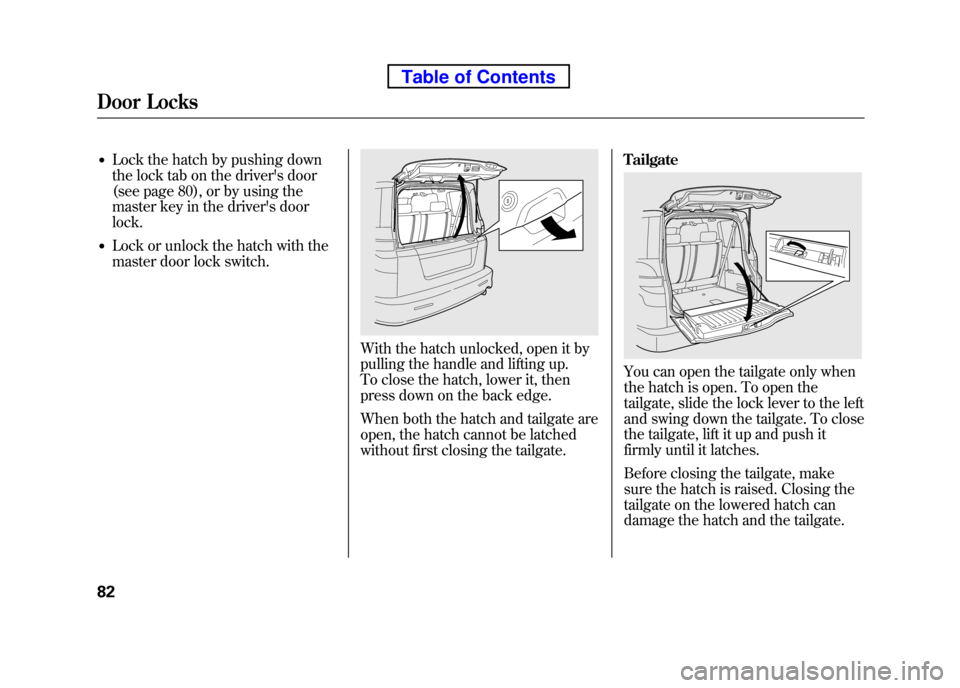
●Lock the hatch by pushing down
the lock tab on the driver's door
(see page 80), or by using the
master key in the driver's door lock.
● Lock or unlock the hatch with the
master door lock switch.
With the hatch unlocked, open it by
pulling the handle and lifting up.
To close the hatch, lower it, then
press down on the back edge.
When both the hatch and tailgate are
open, the hatch cannot be latched
without first closing the tailgate. Tailgate
You can open the tailgate only when
the hatch is open. To open the
tailgate, slide the lock lever to the left
and swing down the tailgate. To close
the tailgate, lift it up and push it
firmly until it latches.
Before closing the tailgate, make
sure the hatch is raised. Closing the
tailgate on the lowered hatch can
damage the hatch and the tailgate.
Door Locks
82
Table of Contents